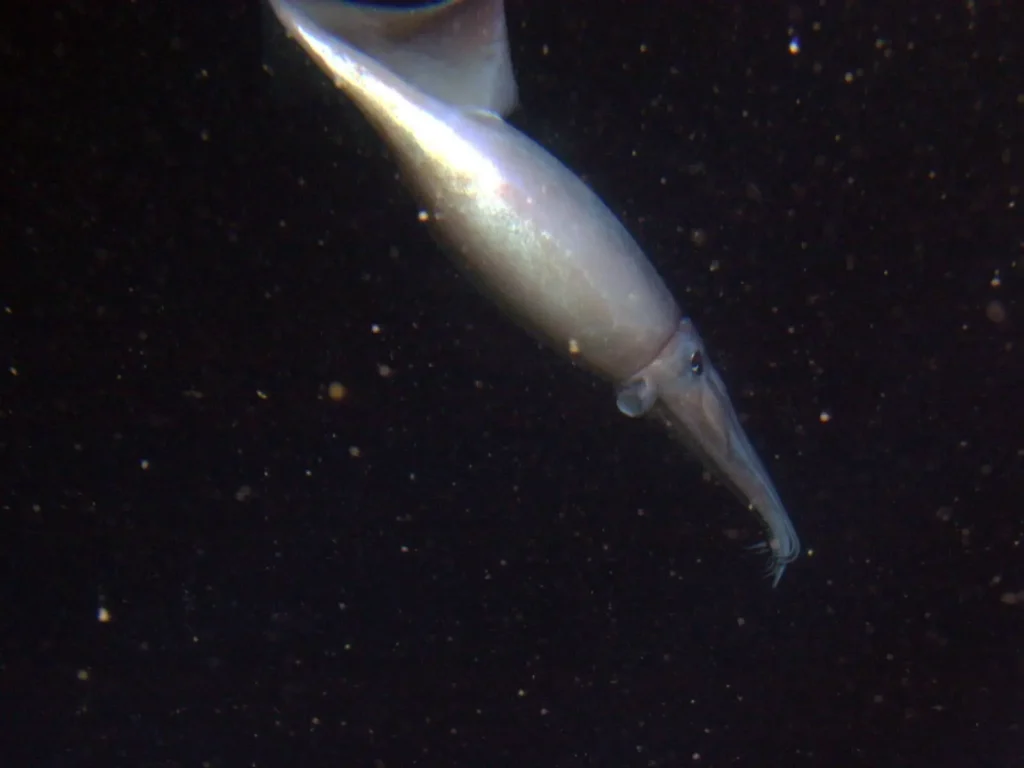Dosidicus gigas, also known as the giant squid or Humboldt squid, is one of the largest members of the squid family found in the oceans. It lives in the southern waters of the Pacific Ocean, especially around the Peruvian and Chilean coasts, and is considered an important fishery target due to its large size and high economic value.

Classification
• Kingdom: Animals (Animalia)
- Type: Mollusca
- Class: Cephalopoda
- Family: Squid (Teuthida)
- Family: Ommastrephidae
- Genus: Dosidicus
- Species: Dosidicus gigas
Appearance
📏 Sizes
- Length: up to 2.5 meters, with some individuals reaching 3 meters.
- Weight: up to 50 kg.
🎨 Features
- The body is elongated in length, with a fleshy mantle that provides the squid with the strength to swim fast.
- Large, well-developed tentacles that can reach 10 meters in length.
- It has a special ability to change color due to chromatophores, which allows it to be camouflaged in the environment.
- Sharp, powerful tentacles with suction cups for grabbing prey.
Range and habitat
🌍 Area
- The giant squid is found in the cold and temperate waters of the Pacific Ocean, particularly along the coasts of Peru and Chile.
- It also occurs in other parts of the Pacific Ocean, including the areas around the Galapagos Islands.
🌊 Living environment
- A pelagic species that lives at various depths, from the surface to 700 meters, often in waters where the temperature ranges from 12 to 18°C.
- During its lifetime, the giant squid can migrate between different depths of the ocean depending on its food needs and water temperature.

Behavior and nutrition
🍽️ Ration
- The squid's diet consists of fish, small squid, and crustaceans.
- This species is an active predator that hunts its prey at night, thanks to its ability to move quickly thanks to a jet stream of water.
🧠 Behavior
- It is known for its aggressive behavior during hunting.
- Depending on the environmental conditions, the giant squid can actively pursue its prey or use ambush techniques to catch its victims.
- It can quickly change color for camouflage or to deter predators.
Enemies
🐋 Natural enemies
- Sperm whales are the main predators of this species. You can often see marks on the squid's body from fighting sperm whales.
- It can also be eaten by large sharks and other marine predators.
Reproduction
- Giant squids reproduce through eggs that females lay on the seabed or on underwater objects.
- The reproduction process is not well understood, as these squids live in deep water, which makes it difficult to observe their behavior in the wild.
Protection status
📉 Protection status
- According to the International Union for Conservation of Nature (IUCN), the squid's status is Least Concern, as the population of this species remains stable.
- However, the giant squid is a target of commercial fishing, and overfishing can be a problem for the conservation of the species.
Interesting facts
✔️ The giant squid is actively used in fishing, especially in Peru, where its meat is an important export product.
✔️ The remains of the squid Dosidicus gigas are regularly found in the stomachs of sperm whales.
✔️ The giant squid is one of the largest invertebrates on Earth, making it a popular subject for scientific research and documentaries.
Conclusion
Dosidicus gigas is one of the largest and most well-known squids in the world, and is essential to the Pacific Ocean ecosystem. Its size, camouflage ability and powerful predatory skills make it unique among other cephalopods.